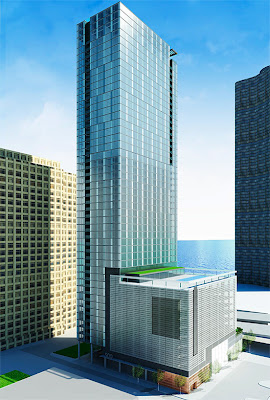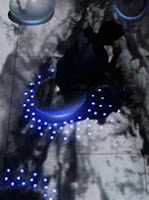There will now be a ten second pause for you to respond, "Who Cares?"
If you're willing to indulge me a bit further . . .
Rahm Emanuel has been anointed - by the pollsters, by the media, by the smart money - as our next mayor-for-life. His television ads punch through the theme that he's "strong", he's "tough." No dispute, those are qualities any successful politician requires. But I suggest the last thing Chicago needs right now is still another "strongman" mayor, the kind of person who knows how to crack the whip, centralize the power, and make it either his way or the highway.
That's exactly the kind of monopoly of power, and vacuum of leadership, that's brought Chicago to its current crisis crossroads.
There's a 1966 film,
Faraon, or
Pharoah, from director Jerzy Kawalerowicz. It begins with the image of two sacred beetles fighting to the death in the scorching desert, and it follows the story of Ramses XIII and his struggle to unite squabbling forces to rise up and oppose the corruption of the all-powerful temple priests. Finally, he wins them over, gains their trust, and they all gather before the palace, waiting for him, to lead them into the epic battle on which the future of the kingdom will be decided. And they wait. In the blazing, pitiless sun they wait. The massive assembled forces grow listless, and begin to realize they are powerless. What they do not know, but will soon find out, is Pharoah, the one, indispensable man, has been assassinated. The camera moves forward into the palace. Forward, into nothing but darkness.
Chicago is not Egypt, nor, despite the title of a fine biography of Richard J. Daley, were either he or his son Pharoahs. They both came to be seen, however, as indispensable men. Election after election, they were re-elected with massive majorities, as fewer and fewer voters cared enough to show up to vote. They began to believe their own press clippings, the words of the various sycophants with which they surrounded themselves. They made stupid mistakes, because there was no real opposition to save them from themselves. Hence the parking meter deal, the emptying out of the billions from the privitization deals to buy time time rather than address critical problems. Last year, Mayor Richard M. Daley bet everything on the 2016 Olympics - admitting he had "nothing else up his sleeve" to secure the city's future - and he lost, big-time. He had become such a big fish in his local pond it never occured to him that, when it came to the International Olympics Committee, he might not be the only one who could play under-the-table hardball politics.
The triumph of Mayor Richard M. Daley's later terms - Millennium Park - was an illustration of a different way of doing things. It succeeded because he got of the way and let others run the show.
Daley's Millennium Park, which his various minions rushed to complete by the new century's start to gain favor with their king, was a dismal failure. The co-authored Millennium Park - of Penny Pritzker, Frank Gehry, Jaume Plensa, Anish Kapoor, John Bryan, Ed Uhlir and SOM - was a smashing international success. Contrast it to the fiasco of the Chicago Children's Museum, which, despite Daley's bullying rants and determination to muscle it through single-handed, has gone nowhere. Thank goodness.
At this crossroads in Chicago's history, we don't need another strongman. We don't need another ever smaller coterie of trusted loyalists rotating from heading one agency to the next as if government were a kind of shell game.
What we
do need is a very deep bench, drawn from the best minds of the city, and a leader who can bring them together and keep them focused.
I am not convinced Rahm Emanuel is that man. He is a creature of the machine. Dick Mell got him elected to Congress and he appears the first choice of many of the same roster of miscreants in his run for Mayor. His campaign has been intentionally vague, devoid of specifics, and replete with platitudes.
We are being asked to elect him on faith, on the strength of his character, but the only really strong part of his campaign is the unstated assumption that there is really no other choice. It is possible, I concede, that Mr. Emanuel could confound us, not be a captive of the old school hacks, bring the needed creativity to Chicago government, and enlist the quality of people we need to get the job done.
For me, however, I've seen how this movie plays out too many times to expect a different ending this time.
Of the other major candidates, Gery Chico presents himself as independent, but he is also very much a creature of the old machine, a former Daley chief of staff, and far too close to corrupt old wolves like Ed Burke. When serving in the Illinois legislature, Carol Mosely Braun was the epitome of a progressive legislator, but she seems to have lost her way. Her recent gaffes, such as hurling out a delusional charge that her opponent was "strung out on crack", makes her appear unhinged. Our mayors-for-life already seem to veer toward the unhinged by the end of their reigns. Why would we want a mayor who starts out that way?
Which brings us to
Miguel del Valle. Because he speaks quietly, he assumes the risk of being perceived as weak. Because his independent credentials are impeccable, going all the way back to support Harold Washington's first campaign, and defeating a crook like Tom Keane to become Illinois' first Latino Senator, you might be tempted to see him as a marginal outsider. But this was the man Richard M. Daley turned to, appointing him City Clerk, an office del Valle's used to make Chicago government more efficient and transparent.
When you read his answers to questionnaires, you don't get the sense of something written by committee, vetted and revetted until everyone's sure no one will be offended, but carefully reasoned, thoughtful, personal responses. He is a proven - not promised - progressive, a champion of working people, not of the corporations that write the big campaign checks. His integrity is not a matter for speculation, but a career constant.
He is calm - a quality we need. He is intelligent, beyond contention. Not to romanticize poverty, but because he hasn't raised millions for big TV buys, he owes those special interests - nothing. A very good place to begin.
I know what's supposed to happen tomorrow. I also remember that one definition of insanity is to keep repeating the same actions and expect a different result.
I believe Miguel del Valle is exactly the clean break, the kind of competent, independent, and intelligent leader that Chicago requires to get us through this very difficult time. You can check him out further on his website
here.
That's why I'm voting for Miguel del Valle. Join me if you dare.














































